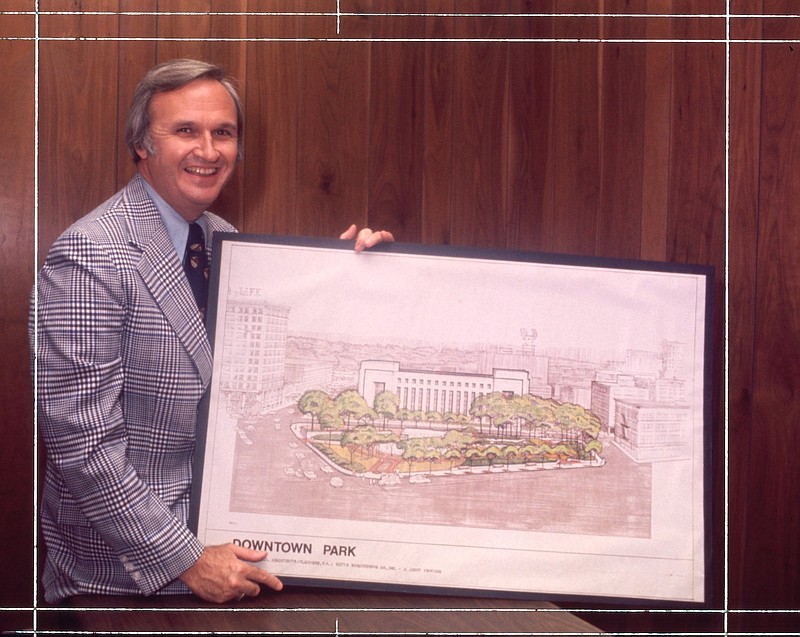(Editor's note: First of two parts)
Almost weekly, Chattanooga residents see an announcement about an event scheduled for Miller Park, the city's central community space. From musical performances to social action gatherings, Miller Park has become an anchor site for the exchange of ideas and meaningful interactions. As the city moves forward with exciting plans for the revitalization of some area parks and the creation of new parks for multi-use, a glance backward is appropriate.
Fifty years ago, a central-city park was still an idea. The announcement by Chattanooga Mayor Robert Kirk Walker's office on Sept. 16, 1973, "City to Raze Block for Park," was a front-page headline in the News-Free Press, and the weekly coverage continued. The full city block, across from the federal building on Georgia Avenue, would be acquired using a combination of $1 million in private donations and an anticipated $500,000 city funding.
The mayor shared that discussions about a park and the requisite funding requirements had begun shortly after his election in 1971 and that Scott L. Probasco Jr., chairman of the Planning and Acquisition Committee, deserved the credit, along with his committee members, for securing private support for the public project. The committee members -- Probasco, Cranston Pearce, H. James Hitching and Joseph H. Davenport, with assistance from George L. McInturff -- would negotiate for the properties, arranging for the land transfers to city. At the end of 90 days, the other required properties would be acquired through condemnation. The city block, bounded by Ninth Street (now MLK Boulevard), Georgia Avenue, 10th Street and Market Street, included a variety of businesses and several vacant, deteriorating buildings.
"Fulfillment of Chattanooga's dream of a downtown park has been one of the important goals of our administration," Walker noted. "Coupled with the exciting prospect of development of the Union Station property, the new library and the many other significant developments planned or already under way, the park assures that Chattanooga will have a downtown area worthy of the pride we all feel in our city."
Probasco echoed the mayor's excitement by identifying two major functions the park would serve. "We sincerely believe that such a park at this location will not only furnish rest and recreation to our people in the downtown business area but will be a great step in the beautification of the community." The unveiled plans included a park that would include trees, grasses, a variety of shrubs and flowers while simultaneously serving as perfect vantage point for viewing the historic federal building.
Six days later, the City Commission approved the allocation of funds for the park, and the planning process moved forward.
By July 1974, a conceptual plan for the park had been approved. Seven Chattanooga firms had indicated an interest in the design project: Harrison, Gill and Associates, Derthick and Henley, Selmon T. Franklin Associates, James Franklin, Frank Gibson, Hensley-Schmidt, and Wamp and Wallace. Interviews began two months later, with each firm slotted a 30-minute presentation period that was to focus on experience and ideas. The committee reserved the right for a 15-minute, question-answer time following each presentation.
On Oct. 1, the newly designed Downtown Park Board announced that, following the presentations and reviews, they had voted unanimously to "negotiate with James Franklin, Architects/Planners and Betts Engineering Company," who had submitted a joint proposal. Franklin had stressed the importance that the park "not become a sterile, uninhabited barren plaza," but instead, through the use of texture changes, flow, levels, colors and other design elements, the park must be designed to provide "not only a more beautiful but a more comfortable environment" for families and individuals.
One year later, demolition was proceeding and the remaining businesses, including Standard Furniture, the Quickie, Shimmy's Liquor Store and First Federal, were expected to vacate their buildings, according to the master timetable. On Sept. 18, 1975, representatives of First Federal -- board Chairman Cartter Patten and President Harry White -- met with Walker, now the former mayor and Downtown Park Board chairman, Chattanooga Mayor Pat Rose and Commissioner Jim Eberle to transfer ownership of the First Federal property and to announce that the financial firm had purchased property at Sixth and Market streets for a new building to be designed by Derthick and Henley, Architects.
Chattanooga's central park was progressing from concept to reality, always remaining true to architect Jim Franklin's core belief that "the real client is the person who's going to use the park."
Linda Moss Mines, the Chattanooga-Hamilton County historian, is a "parks advocate" and honorary regent, Chief John Ross Chapter, NSDAR. Go to Chattahistoricalassoc.org for more information.
